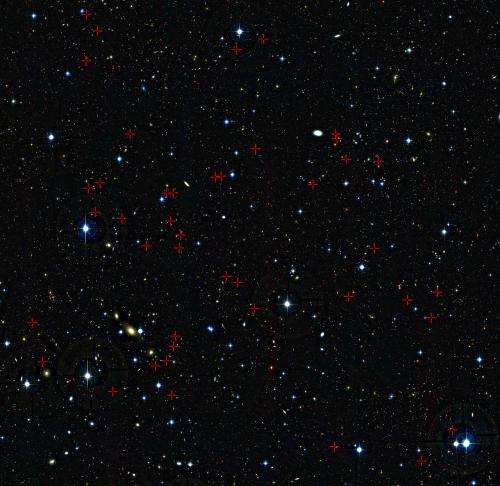The feeding habits of teenage galaxies

(PhysOrg.com) -- New observations made with ESO’s Very Large Telescope are making a major contribution to understanding the growth of adolescent galaxies. In the biggest survey of its kind astronomers have found that galaxies changed their eating habits during their teenage years - the period from about 3 to 5 billion years after the Big Bang. At the start of this phase smooth gas flow was the preferred snack, but later, galaxies mostly grew by cannibalising other smaller galaxies.
Astronomers have known for some time that the earliest galaxies were much smaller than the impressive spiral and elliptical galaxies that now fill the Universe. Over the lifetime of the cosmos galaxies have put on a great deal of weight but their food, and eating habits, are still mysterious. A new survey of carefully selected galaxies has focussed on their teenage years — roughly the period from about 3 to 5 billion years after the Big Bang.
By employing the state-of-the-art instruments on ESO's Very Large Telescope an international team is unravelling what really happened. In more than one hundred hours of observations the team has collected the biggest ever set of detailed observations of gas-rich galaxies at this early stage of their development.
"Two different ways of growing galaxies are competing: violent merging events when larger galaxies eat smaller ones, or a smoother and continuous flow of gas onto galaxies. Both can lead to lots of new stars being created," explains Thierry Contini (IRAP, Toulouse, France), who leads the work.
The new results point toward a big change in the cosmic evolution of galaxies, when the Universe was between 3 and 5 billion years old. Smooth gas flow (eso1040) seems to have been a big factor in the building of galaxies in the very young Universe, whereas mergers became more important later.
"To understand how galaxies grew and evolved we need to look at them in the greatest possible detail. The SINFONI instrument on ESO's VLT is one of the most powerful tools in the world to dissect young and distant galaxies. It plays the same role that a microscope does for a biologist," adds Thierry Contini.
Distant galaxies like the ones in the survey are just tiny faint blobs in the sky, but the high image quality from the VLT used with the SINFONI instrument means that the astronomers can make maps of how different parts of the galaxies are moving and what they are made of. There were some surprises.
"For me, the biggest surprise was the discovery of many galaxies with no rotation of their gas. Such galaxies are not observed in the nearby Universe. None of the current theories predict these objects," says Benoit Epinat, another member of the team.
"We also didn't expect that so many of the young galaxies in the survey would have heavier elements concentrated in their outer parts — this is the exact opposite of what we see in galaxies today," adds Thierry Contini.
The team are only just starting to explore their rich set of observations. They plan to also observe the galaxies with future instruments on the VLT as well as using ALMA to study the cold gas in these galaxies. Looking further into the future the European Extremely Large Telescope will be ideally equipped to extend this type of study deeper into the early Universe.
More information: This research was presented in four papers describing the MASSIV survey that will appear in the journal Astronomy & Astrophysics.
Journal information: Astronomy & Astrophysics
Provided by ESO





















